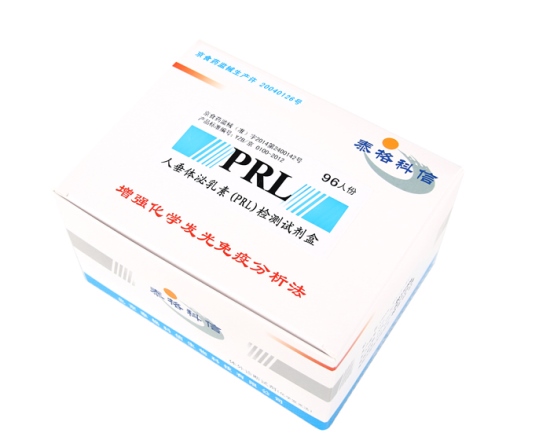

Detection Kit for Human pituitary prolactin (PRL)
( Enhanced chemiluminescence immunoassay)

【Product Name】Detection Kit for Human pituitary prolactin (PRL) (Enhanced chemiluminescence immunoassay)
【registration certificate number】 京食药监械(准)字2014第2400142号
This kit is mainly used for quantitative determination of human pituitary prolactin (PRL) in human serum in vitro.
Human pituitary prolactin (PRL) is produced by the anterior pituitary, determination of PRL has important meaning for pituitary diseases especially pituitary tumors, hyperprolactinemia caused by various reasons, and the diagnosis of hypothalamic disease. It is also has great significance for abnormal menstruation and diagnosis of infertility.
The kit uses a sandwich method. Microplates were coated with one anti-PRL to make a solid-phase antibody and the other labeled with HRP into anti-PRL -HRP. PRL (standard or test sample) is added to the wells coated with the antibody to form a complex called antibody-antigen-HRP labeled antibody. The unbound anti-PRL-HRP was removed after the immunoreaction, the luminescence was measured with a photon counter after adding the luminescent substrate. With the increase of FSH concentration, the luminescence value gradually increases and keep a linear relation. Use double logarithm or other suitable fitting method and the instrument software will automatically calculate the PRL content of the sample.
1. High Sensitivity: chemiluminescence immuno assay can detect the substance that radioimmunoassay, enzyme-linked immunosorbent assay and other methods can not, early diagnosis of disease is of great significance.
2. Short Detection time: the optical signal measurement time of each sample is less than a second, which is very necessary for emergency situations in medical and health work (such as rescue, blood transfusion, emergency surgery, remote treatment, etc.).
3. Excellent stability: the validity period is up to one year, which is conducive to the popularization and application.
4. Simple and fast operation: Chemiluminescence immunoassay is simple and fast, the test can be completed one hour and projects commonly used can print report one hour.
5. Fast, good security: chemiluminescence immunoassay does not involve harmful chemical composition for human, although there are also waste exclusion, no harmful pollution to the environment.
Common symptoms: lactation, obesity, skin pigmentation, menstrual disorders
The clinical symptoms of prolactinoma-induced hyperprolactinemia vary depending on the sex, age, duration of high PRL episodes, and tumor size. It is commonly in women and often manifested as galactorrhea - amenorrhea syndrome. Tumor size and PRL concentrations in serum were positively correlated.
1. Female PRL tumor
It found in 20 to 30-year-old female youth, and often manifested as micro-adenoma. Typical clinical manifestation is amenorrhea - galactosis - infertility triad symptoms. The main symptoms in pre-adolescent women showed delayed puberty, growth retardation and primary amenorrhea, The main symptoms in post-adolescent women showed shortened menstrual period, menstrual blood volume is scarce or excessive, menstrual delay, loss of libido or absence, loss of sex, orgasm, sex with pain, abortion, infertility and so on. Signs visible are breast atrophy, pubic hair loss, genital atrophy, reduction of vaginal discharge and so on.
2. Male PRL tumor
Male prolactinoma is larger and most develops upward, it is relatively rare. The main clinical manifestations is complete or partial sexual dysfunction, such as loss of libido, impotence, male breast development, male infertility, reduction of the number of sperm. Slow progress of symptoms is not easy to pay attention, when treatment has been advanced, imaging detection is mostly large adenoma, nerve compression is more obvious. Physical examination found that adolescent patients may appear stagnation of adolescence, abnormal body, breast development and triggering lactation, small testes, adults may appear thin beard, breast development and triggering lactation, scarce pubic hair, testicular soft.
3. Tumor compression syndrome
Late PRL tumors and other types of pituitary adenomas, hypothalamus and parasellar tumors, due to the huge tumor and expansion to the saddle, can block PIF and cause high PRL hyperlipidemia, common local compression symptoms are headache, visual abnormalities. The cause of headache is increased intracranial pressure caused by adenoma, accompanied by nausea and vomiting. Headache incidence of men with PRL tumor is higher than that of women. Some micro-adenoma occupies little lesions, but it also cause a headache, the reason is not clear.
4.Osteoporosis
Sometimes prolonged PRL hyperlipidemia patients with PRL tumors can be diagnosed as osteoporosis at the first diagnosis. After treatment to restore normal prolactin levels and gonadal function, bone density can be improved, but sometimes can not be fully restored to normal.
5.Acute pituitary apoplexy
If the PRL tumor with rapid growth is internal bleeding and acute pituitary apoplexy, it manifested as sudden severe headache, nausea, vomiting and decreased visual acuity and other symptoms of cranial nerve compression, and even coma and eyeballs, which need for emergency treatment. The patient can develop pituitary hypothyroidism after successful resuscitation.
Clinical laboratory, physical examination center.